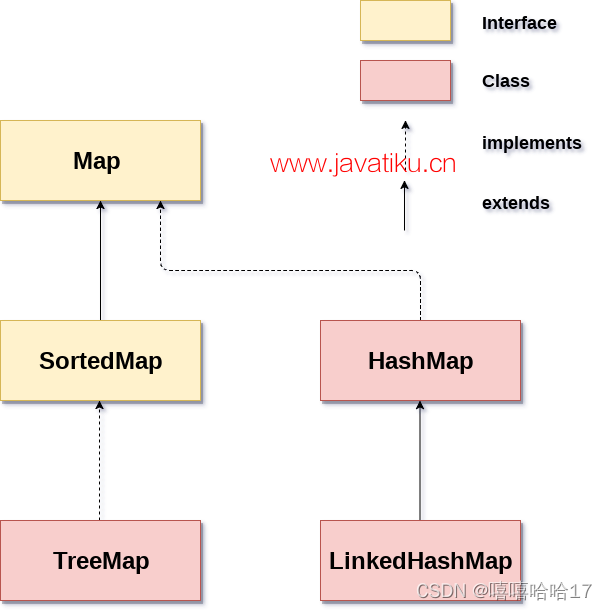java-map接口学习
- Java Map接口
- HashMap
- LinkedHashMap
- TreeMap
- 例子
Java Map接口
-
Map接口是基于键(key)和值(value)对的集合。每个键值对被称为一个条目(entry)。Map中的键是唯一的。
-
如果需要根据键进行搜索、更新或删Java Map接口除元素,那么Map是很有用的。
-
在Java中,有两个接口用于实现Map:Map和SortedMap,以及三个类:HashMap、LinkedHashMap和TreeMap。Java Map的层次结构如下所示:

-
Map不允许重复的键,但可以有重复的值。HashMap和LinkedHashMap允许使用null键和null值,但TreeMap不允许使用null键或null值。
-
Map不能直接遍历,因此需要使用keySet()或entrySet()方法将其转换为Set。
-
HashMap HashMap是Map的实现,但它不维护任何顺序。
-
LinkedHashMap LinkedHashMap是Map的实现,它继承自HashMap类,并且按照插入顺序维护元素顺序。
-
TreeMap TreeMap是Map和SortedMap的实现,它按照升序维护元素顺序。
HashMap
import org.junit.Test;
import java.util.*;public class TestMap {@Testpublic void test_hashmap() {Map map1 = new HashMap();// 非泛型Map<Integer, String> map = new HashMap<Integer, String>();//泛型//向map中添加元素map.put(1, "Amit");map.put(5, "Rahul");map.put(2, "Jai");map.put(6, "Amit");//遍历MapSet set = map.entrySet();//转换为Set以便遍历Iterator itr = set.iterator();while (itr.hasNext()) {//转换为Map.Entry以便分别获取键和值Map.Entry entry = (Map.Entry) itr.next();System.out.println(entry.getKey() + " " + entry.getValue());}//元素可以以任何顺序遍历 注意 必须是泛型 指定key value 的类型for(Map.Entry m:map.entrySet()){System.out.println(m.getKey()+" "+m.getValue());}}@Test //比较public void compared(){Map<Integer,String> map=new HashMap<Integer,String>();map.put(100,"Amit");map.put(101,"Vijay");map.put(102,"Rahul");//按照 键 比较//返回包含此Map中的映射的Set视图map.entrySet()//返回以此集合为源的顺序流.stream()//根据提供的比较器进行排序.sorted(Map.Entry.comparingByKey())//对流中的每个元素执行操作.forEach(System.out::println);//按照 键 比较 逆序map.entrySet()//返回以此集合为源的顺序流.stream()//根据提供的比较器进行排序.sorted(Map.Entry.comparingByKey(Comparator.reverseOrder()))//对流中的每个元素执行操作.forEach(System.out::println);//按照 值 比较//返回包含此Map中的映射的Set视图map.entrySet()//返回以此集合为源的顺序流.stream()//根据提供的比较器进行排序.sorted(Map.Entry.comparingByValue())//对流中的每个元素执行操作.forEach(System.out::println);//按照 值 降序比较map.entrySet()//返回以此集合为源的顺序流.stream()//根据提供的比较器进行排序.sorted(Map.Entry.comparingByValue(Comparator.reverseOrder()))//对流中的每个元素执行操作.forEach(System.out::println);}
}
LinkedHashMap
@Test //public void LHmap(){LinkedHashMap<Integer,String> hm=new LinkedHashMap<Integer,String>();hm.put(1,"yawei");hm.put(2,"honglou");hm.put(3,"amei");for(Map.Entry m:hm.entrySet()){System.out.println(m.getKey()+" "+m.getValue());}//获取键 列表System.out.println(hm.keySet());//获取值 列表System.out.println(hm.values());//获取键值对System.out.println(hm.entrySet());//remove函数hm.remove(1);System.out.println(hm);}
TreeMap
- TreeMap类是基于红黑树实现的。它提供了一种在排序顺序中高效存储键值对的方式。
@Testpublic void Treemap(){TreeMap<Integer, String> map = new TreeMap<Integer, String>();map.put(100, "Amneda");map.put(102, "yankou");map.put(101, "shifu");map.put(103, "hhh");for (Map.Entry<Integer, String> entry : map.entrySet()) {System.out.println(entry.getKey() + " " + entry.getValue());}//remove 函数map.remove(103);System.out.println(map);//降序System.out.println(map.descendingMap());// 返回键小于或等于指定键的键值对System.out.println(map.headMap(102));// 返回键大于或等于指定键的键值对System.out.println("tailMap: " + map.tailMap(102, true));// 返回存在于指定键之间的键值对System.out.println("subMap: " + map.subMap(100, false, 102, true));}
例子
@Testpublic void ex_map(){HashMap<Integer, Integer> map = new HashMap<>();map.put(1,1);map.put(2,2);map.compute(1,(key,value)->value+1);System.out.println(map);}

- 如何设计一个优秀的SQL审核引擎)

)
)





![[Python学习篇] Python注释](http://pic.xiahunao.cn/[Python学习篇] Python注释)
基本概念)


-初级渗透测试)
)

——无名管道及有名管道使用例程)

